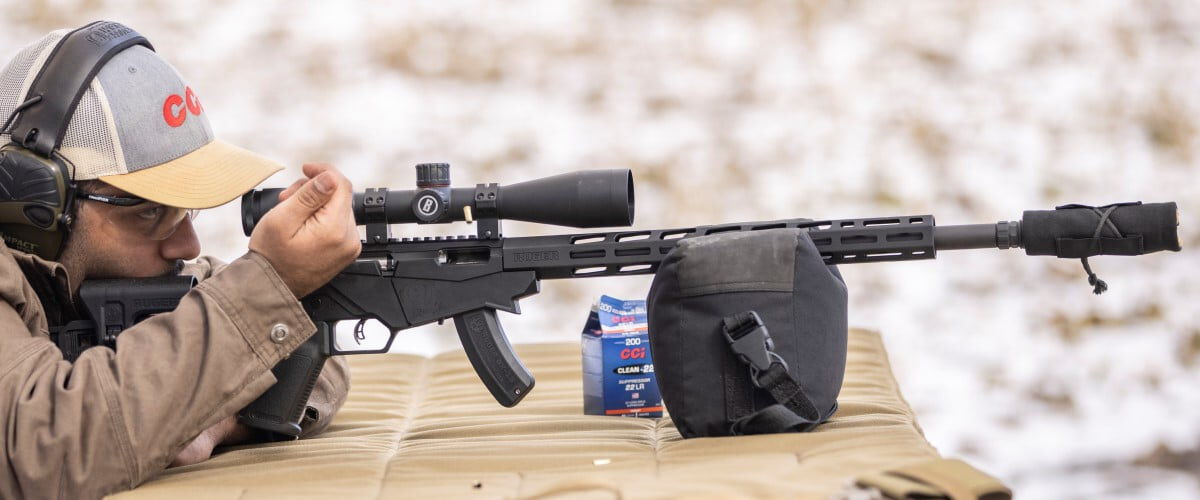
Any shooter who has plinked at pop cans or hunted squirrels knows that a good rest improves shooting performance. But rests come in many forms nowadays, and filtering through those choices can be confusing. Don’t fret. Rimfire expert and CCI ambassador Todd Jarrett says choosing the right rest boils down to the type of shooting and hunting you intend to do.
“I would research different companies for the best devices that fit the area that you actually hunt in or compete in,” he says. From there, the advantages of each type of rest become clearer.
Bags
The process of finding an ideal rest actually begins before you take your rimfire rifle afield or to a match.
“The first thing is getting the proper gun rest to zero your gun,” he says. “Getting ready for the field, competition or hunting, I personally like to use sandbags. There are many companies that make them. They give me a good zero and a good bit of practice to understand where the rifle needs to be to shoot that perfect group with the ammunition I’m going to be using.”
But shooting bags are useful for far more than simply sighting in. The best shooters also incorporate a rear shooting bag placed under the butt of the rifle. This adds tremendous stability to an already solid rest, eliminating side-to-side wobble shooters will see when only supporting the fore-end of the rifle. It also makes it easy for shooters to make precise adjustments to elevation by squeezing or relaxing their hold on the bag with their non-dominant hand.
Monopods
As the name implies, a monopod is simply a single staff or pole on which you can rest your rifle (or handgun). They’re great for hunting situations that require quick setups. Jarrett frequently uses a monopod for squirrel hunting, as it’s light, easy to carry and can double as a walking stick. However, monopods allow the gun to move left or right, so shooters must use a specialized technique.
“The goal is in a hunting situation, whenever possible, is to use a reverse kneel if I have to kneel with the monopod,” Jarrett says. “For a right-handed shooter, that means your right elbow needs to sit on your knee or thigh if you’re going to make an upward shot. That creates more stability.”Jarrett says it’s also wise to rest against a tree or another object to further stabilize your sight, scope or red-dot.
“I want to be able to touch anything I can, whether it be a tree branch, a tree, a stump—anything that can help me stabilize it,” he says. “Being able to touch that object will help me make a more precise shot.”
Bipods
These two-legged rests are very popular, especially with Western hunters and long-range shooters. They can be set up quickly and provide a very stable shooting platform.
“I’m a huge fan of bipods on my rifles, and I use them all the time,” Jarrett says. “It’s absolutely necessary on your rifle if you’re in a hunting situation in more of a flat-land scenario, whether you’re shooting prairie dogs, squirrels, rabbits or any other type of open hunting situation.”
Bipods come in various sizes, ranging from 8 to even 36 inches high. Narrowing your choice depends on your hunting situation.

“If you’re shooting game with it, you might want to go with a longer bipod,” Jarrett says. “I really like the 2-foot bipods in a hunting situation so I can sit down and do an elevated shot or a downward shot if necessary.”
Field Pods
These are tripods on which you can set your rifle for precision distance shooting. They might not be ideal for every hunting situation, but they shine in many applications.
“They’re much more cumbersome to use, but they’ll give you a precise shot, as if you’re sitting on the bench,” Jarrett says. “There are many different types. And they can be very expensive. But they can be a wonder for you in a hunting situation or if you want to shoot for distance and practice for distance.”
The Key
Finally, various styles of rests also share a common consideration: You must practice with them to understand their nuances and become proficient.
“If you don’t practice, you won’t understand how to stabilize your body correctly by using all of these types of methods,” Jarrett says. “It’s a familiarity thing. Recoil matters, whether you’re using a .22 or a centerfire rifle, or a semi-auto or bolt gun. It makes a difference.”
Maxi-Mag TMJ
Meet a plinking powerhouse. Maxi-Mag TMJ uses a 40-grain lead bullet that's seamlessly encased in a copper jacket to provide accuracy you're not going to find elsewhere.
Buy Now